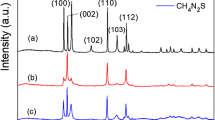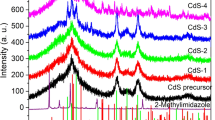Abstract
CdS with different morphologies were prepared by simple methods (mainly by water bath) with different solvents, including CdS nanoparticles (CdS-0), CdS nanorods (CdS-1), CdS nanosheets (CdS-2), and CdS nanospheres (CdS-3). The structures and morphologies of as-prepared samples were characterized by XRD, XPS, UV–vis DRS, TEM, and SEM. All the prepared samples were used for the photoreduction of Cr (VI) to characterize the photocatalytic performance. CdS-1 shows the highest photocatalytic efficiency was prepared by simply stirring using ethylenediamine as solvent and thiourea as the sulfur source; 98.4% of Cr (VI) can be reduced to Cr (III) within 25 min. The increased photocatalytic activity can be attributed to the high crystallinity and purity, fast separate efficiency, and migration efficiency of electrons (e−) and holes (h+), as well. This work showed that morphologies and crystallinities have significant impact on the Cr (VI) photoreduction efficiency and introduced a simple method for fabricating samples with different morphologies, which add the knowledge for Cr (VI) reduction. Hoping our work can provide a tendency to fabricate efficient photocatalysis via a simple method.









Similar content being viewed by others
References
Ai ZZ, Shao YL, Chang B, Zhang L, Shen JX, Wu YZ, Huang BB, Hao XP (2019) Rational modulation of p-n homojunction in P-doped g-C3N4 decorated with Ti3C2 for photocatalytic overall water splitting. Appl Catal B-Environ 259
Bai X, Jia J, Du YY, Hu XY, Li JL, Liu EZ, Fan J (2020) Multi-level trapped electrons system in enhancing photocatalytic activity of TiO2 nanosheets for simultaneous reduction of Cr (VI) and RhB degradation. Appl Surf Sci 503
Bie CB, Fu JW, Cheng B, Zhang LY (2018) Ultrathin CdS nanosheets with tunable thickness and efficient photocatalytic hydrogen generation. Appl Surf Sci 462:606–614
Bie CB, Zhu BC, Xu FY, Zhang LY, Zhang LG (2019) In situ grown monolayer N-doped graphene on CdS hollow spheres with seamless contact for photocatalytic CO2 reduction. Adv Mater 31(42):1902868
Chen DD, Liu JG, Jia ZZ, Fang JZ, Yang F, Tang YM, Wu K, Liu Z, Fang ZQ (2019) Efficient visible-light-driven hydrogen evolution and Cr(VI) reduction over porous P and Mo co-doped g-C3N4 with feeble N vacancies photocatalyst. J Hazard Mater 361:294–304
Chen FY, Yu CL, Wei LF, Fan QZ, Ma F, Zeng JL, Yi JH, Yang K, Ji HB (2020) Fabrication and characterization of ZnTiO3/Zn2Ti3O8/ZnO ternary photocatalyst for synergetic removal of aqueous organic pollutants and Cr((VI)) ions. Sci Total Environ 706:0048–9697
Fujishima A, Honda K (1972) Electrochemical photolysis of water at a semiconductor electrode. Nature 238:37–39
Fujishima M, Ikeda T, Akashi R, Tada H (2018) In situ shape change of Au nanoparticles on TiO2 by CdS photodeposition: its near-field enhancement effect on photoinduced electron injection from CdS to TiO2. Acs Omega 3(6):6104–6112
Gopannagari M, Kumar DP, Reddy DA, Hong S, Song MI, Kim TK (2017) In situ preparation of few-layered WS2 nanosheets and exfoliation into bilayers on CdS nanorods for ultrafast charge carrier migrations toward enhanced photocatalytic hydrogen production. J Catal 351:153–160
Isaka Y, Kondo Y, Kawase Y, Kuwahara Y, Mori K, Yamashita H (2018) Photocatalytic production of hydrogen peroxide through selective two-electron reduction of dioxygen utilizing amine-functionalized MIL-125 deposited with nickel oxide nanoparticles. Chem Commun 54(67):9270–9273
Jia HM, He WW, Zhang BB, Yao L, Yang XK, Zheng Z (2018) Facile synthesis of bismuth oxyhalide nanosheet films with distinct conduction type and photo-induced charge carrier behavior. Appl Surf Sci 441:832–840
Jing DW, Guo LJ (2006) A novel method for the preparation of a highly stable and active CdS photocatalyst with a special surface nanostructure. J Phys Chem B 110(23):11139–11145
Kar P, Zeng S, Zhang Y, Vahidzadeh E, Manuel A, Kisslinger R, Alam KM, Thakur UK, Mahdi N, Kumar P, Shankar K (2019) High rate CO2 photoreduction using flame annealed TiO2 nanotubes. Appl Catal B-Environ 243:522–536
Khan AA, Kumari S, Chowdhury A, Hussain S (2018) Phase tuned originated dual properties of cobalt sulfide nanostructures as photocatalyst and adsorbent for removal of dye pollutants. Appl Nano Mater 1(7):3474–3485
Khan AA, Chowdhury A, Kumari S, Hussain S (2020) The facile soft-template-morphology-controlled (STMC) synthesis of ZnIn2S4 nanostructures and their excellent morphology-dependent adsorption properties. J Mater Chem A 8(4):1986–2000
Kumar DP, Hong S, Reddy DA, Kim TK (2017) Ultrathin MoS2 layers anchored exfoliated reduced graphene oxide nanosheet hybrid as a highly efficient cocatalyst for CdS nanorods towards enhanced photocatalytic hydrogen production. Appl Catal B-Environ 212:7–14
Li CX, Han LJ, Liu RJ, Li HH, Zhang SJ, Zhang GJ (2012) Controlled synthesis of CdS micro/nano leaves with (0001) facets exposed: enhanced photocatalytic activity toward hydrogen evolution. J Mater Chen 22(45):23815–23820
Li XY, Gao XY, Ai LH, Jiang J (2015) Mechanistic insight into the interaction and adsorption of Cr(VI) with zeolitic imidazolate framework-67 microcrystals from aqueous solution. Chem Eng J 274:238–246
Liang R, Shen L, Jing F, Wu W, Qin N, Lin R, Wu L (2015) NH2-mediated indium metal–organic framework as a novel visible-light-driven photocatalyst for reduction of the aqueous Cr(VI). Appl Catal B-Environ 162:245–251
Liu Y, Ma YJ, Liu WW, Shang YY, Zhu AQ, Tan PF, Xiong X, Pan J (2018a) Facet and morphology dependent photocatalytic hydrogen evolution with CdS nanoflowers using a novel mixed solvothermal strategy. J Colloid Interf Sci 513:222–230
Liu XN, Du PH, Pan WY, Dang CY, Qian TW, Liu HF, Liu W, Zhao DY (2018b) Immobilization of uranium(VI) by niobate/titanate nanoflakes heterojunction through combined adsorption and solar-light-driven photocatalytic reduction. Appl Catal B-Environ 231:11–22
Liu J, Liang XX, Wang YT, Wang B, Zhang TC (2019) Preparation of CdS nanorods on silicon nanopillars surface by hydrothermal method. Mater Res Bull 120:110591
Lv XS, Wei W, Li FP, Huang BB, Dai Y (2019) Metal-free B@g-CN: visible/infrared light-driven single atom photocatalyst enables spontaneous dinitrogen reduction to ammonia. Nano Lett 19(9):6391–6399
Ma S, Xu XM, Xie J, Li X (2017a) Improved visible-light photocatalytic H2 generation over CdS nanosheets decorated by NiS2 and metallic carbon black as dual earth-abundant cocatalysts. Chinese J Catal 38(12):1970–1980
Ma S, Xie J, Wen JQ, He KL, Li X, Liu W, Zhang XC (2017b) Constructing 2D layered hybrid CdS nanosheets/MoS2 heterojunctions for enhanced visible-light photocatalytic H2 generation. Appl Surf Sci 391:580–591
Maimaitizi H, Abulizi A, Kadeer K, Talifu D, Tursun Y (2020) In situ synthesis of Pt and N co-doped hollow hierarchical BiOCl microsphere as an efficient photocatalyst for organic pollutant degradation and photocatalytic CO2 reduction. Appl surf Sci 502
Mu RH, Ao YH, Wu TF, Wang C, Wang PF (2020) Synergistic effect of molybdenum nitride nanoparticles and nitrogen-doped carbon on enhanced photocatalytic hydrogen evolution performance of CdS nanorods. J Alloy Compd 812:151990
Muruganandham M, Kusumoto Y, Okamoto C, Muruganandham A, Abdulla-Al-Mamun M, Ahmmad B (2009) Mineralizer-assisted shape-controlled synthesis, characterization, and photocatalytic evaluation of CdS microcrystals. J Phys Chem C 113(45):19506–19517
Peng TX, Wen YT, Wang CX, Wang YY, Zhang GS, Zhang YC, Dionysiou DD (2019) Preparation of SnO2/conjugated polyvinyl alcohol derivative nanohybrid with good performance in visible light-induced photocatalytic reduction of Cr(VI). Mat Sci Semicon Proc 102
Qiu SJ, Shen YL, Wei GJ, Yao S, Xi W, Shu M, Si R, Zhang M, Zhu JF, An CH (2019) Carbon dots decorated ultrathin CdS nanosheets enabling in-situ anchored Pt single atoms: a highly efficient solar-driven photocatalyst for hydrogen evolution. Appl Catal B-Environ 259:118036
Qu D, Zheng M, Du P, Zhou Y, Zhang LG, Li D, Tan HQ, Zhao Z, Xie ZG, Sun ZC (2013) Highly luminescent S, N co-doped graphene quantum dots with broad visible absorption bands for visible light photocatalysts. Nanoscale 5(24):12272–12277
Ri CN, Kim SG, Ju KS, Ryo HS, Mun CH, Kim UH (2018) The synthesis of a Bi2MoO6 /Bi4V2O11 heterojunction photocatalyst with enhanced visible-light-driven photocatalytic activity. RSC Adv 8:5433–5440
Ruby S, Rosaline DR, Inbanathan SSR, Anand K, Kavitha G, Aeinivasan R (2020) Sunlight-driven photocatalytic degradation of methyl orange based on bismuth ferrite (BiFeO3) heterostructures composed of interconnected nanosheets. J Nanosci Nanotechnol 20(3):1851–1858
Shen LM, Bao NZ, Prevelige PE, Gupta A (2010) Escherichia coli bacteria-templated synthesis of nanoporous cadmium sulfide hollow microrods for efficient photocatalytic hydrogen production. J Phys Chen C114(6):2551–2559
Sun H, Liu ZG, Wang Y, Quan X, Zhao GZ (2019a) Novel metal-organic framework supported manganese oxides for the selective catalytic reduction of NOx with NH3: promotional role of the support. J Hazard Mater 380
Sun GT, Mao SM, Ma DD, Zou YJ, Lv YX, Li ZH, He C, Cheng YH, Shi JW (2019b) Yonghong Cheng, Jian-Wen Shi, One-step vulcanization of Cd(OH)Cl nanorods to synthesize CdS/ZnS/PdS nanotubes for highly efficient photocatalytic hydrogen evolution. J Mater Chen A 7(25):15278–15287
Wang JC, Ren J, Yao HC, Zhang L, Wang JS, Zang SQ, Han LF, Li ZJ (2016) Synergistic photocatalysis of Cr(VI) reduction and 4-Chlorophenol degradation over hydroxylated α-Fe2O3 under visible light irradiation. J Hazard Mater 311:11–19
Wang L, Xu X, Cheng QF, Dou SX, Du Y (2019) Near-infrared-driven photocatalysts: design, construction, and applications. Small 1904107
Yang LX, Liu M, Liu Y, Luo SL, Luo Y, Luo XB, Li GF, Peng P (2016) Theoretical analyses of organic acids assisted surface-catalyzed reduction of Cr-VI on TiO2 nanowire arrays. Appl Catal B-Environ 198:508–515
Yi XH, Ma SQ, Du XD, Zhao C, Fu HF, Wang P, Wang CC (2019) The facile fabrication of 2D/3D Z-scheme g-C3N4/UiO-66 heterojunction with enhanced photocatalytic Cr(VI) reduction performance under white light. Chem Eng J 375:121944
Yu J, Yu Y, Zhou P, Xiao W, Cheng B (2014) Morphology-dependent photocatalytic H2-production activity of CdS. Appl Catal B-Environ 156:184–191
Yu CL, Chen FY, Zeng DB, Xie Y, Zhou WQ, Liu Z, Wei LF, Yang K, Li DH (2019) A facile phase transformation strategy for fabrication of novel Z-scheme ternary heterojunctions with efficient photocatalytic properties. Nanoscale 11(16):7720–7733
Yu CL, Zeng DB, Fan QZ, Yang K, Zeng JL, Wei LF, Yi JH, Ji HB (2020) The distinct role of boron doping in Sn3O4 microspheres for synergistic removal of phenols and Cr(vi) in simulated wastewater. Environ Sci-Nano 7(1):286–303
Zeng DB, Yu CL, Fan QZ, Zeng JL, Wei LF, Li ZS, Yang K, Ji HB (2019) Theoretical and experimental research of novel fluorine doped hierarchical Sn3O4 microspheres with excellent photocatalytic performance for removal of Cr(VI) and organic pollutants. Chem Eng J 391:123607
Zhang GP, Chen DY, Li NJ, Xu QF, Li H, He JH, Lu JM (2019) Fabrication of Bi2MoO6/ZnO hierarchical heterostructures with enhanced visible-light photocatalytic activity. Appl Catal B-Environ 250:313–324
Zhu C, Liu CG, Zhou YJ, Guo SJ, Li H, Zhao SQ, Huang H, Liu Y, Kang ZH (2017) Carbon dots enhance the stability of CdS for visible-light-driven overall water splitting. Appl Catal B-Environ 216:114–121
Zhu LY, Li H, Xia PF, Liu ZR, Xiong DH (2018) Hierarchical ZnO decorated with CeO2 nanoparticles as the direct Z-scheme heterojunction for enhanced photocatalytic activity. ACS Appl Mater Inter 10:39679–39687
Funding
This work was supported by the National Natural Science Foundation of China (Grant No. 51872141 and Grant No. 51572126).
Author information
Authors and Affiliations
Corresponding authors
Ethics declarations
Conflict of interest
The authors declare that they have no conflict of interest.
Additional information
Publisher’s note
Springer Nature remains neutral with regard to jurisdictional claims in published maps and institutional affiliations.
Electronic supplementary material
ESM 1
(DOCX 19 kb)
Rights and permissions
About this article
Cite this article
Cao, Y., Yin, H., Fan, T. et al. Morphology-dependent of nanosizes CdS toward efficient photocatalytic Cr (VI) reduction. J Nanopart Res 22, 217 (2020). https://doi.org/10.1007/s11051-020-04926-3
Received:
Accepted:
Published:
DOI: https://doi.org/10.1007/s11051-020-04926-3




